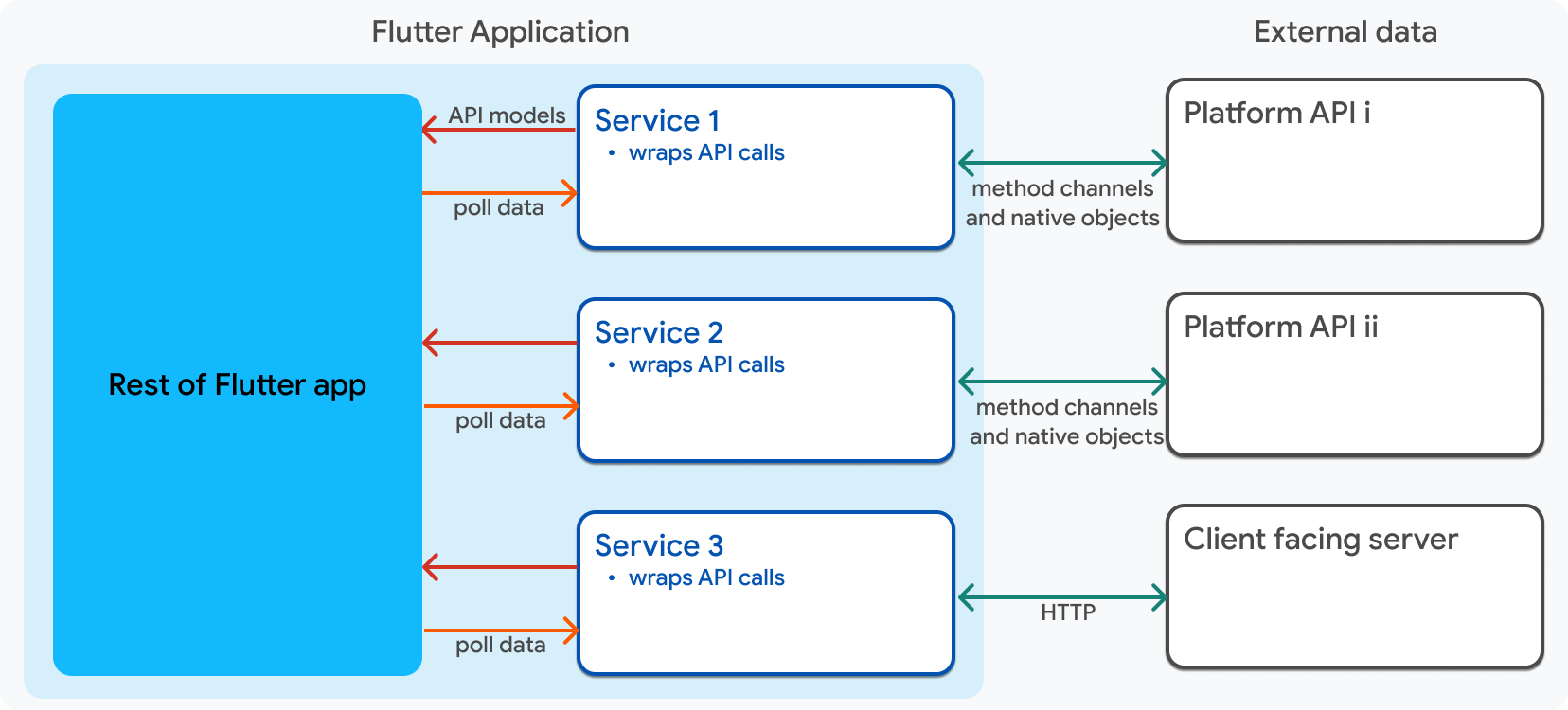数据层
应用程序的数据层,在 MVVM 术语中称为模型,是所有应用程序数据的真相来源。作为真相来源,它是应用程序数据应该被更新的唯一地方。
它负责从各种外部 API 消耗数据,将这些数据暴露给 UI,处理需要更新数据的 UI 事件,并在需要时将更新请求发送到这些外部 API。

- 仓库是应用程序数据的真相来源,并包含与该数据相关联的逻辑,例如响应新的用户事件更新数据或轮询服务获取数据。仓库负责在支持离线功能时同步数据,管理重试逻辑以及缓存数据。
- 服务是与 API(如 HTTP 服务器和平台插件)交互的无状态 Dart 类。您的应用程序需要的任何不在应用程序代码本身内部创建的数据都应该从服务类中获取。
定义一个服务
#服务类是所有架构组件中最明确的一个。它是无状态的,其函数没有副作用。它的唯一工作是封装外部 API。通常每个数据源有一个服务类,例如客户端 HTTP 服务器或平台插件。

例如,在 Compass 应用中,有一个 APIClient 服务,它处理到面向客户的服务器的 CRUD 调用。
class ApiClient {
// Some code omitted for demo purposes.
Future<Result<List<ContinentApiModel>>> getContinents() async { /* ... */ }
Future<Result<List<DestinationApiModel>>> getDestinations() async { /* ... */ }
Future<Result<List<ActivityApiModel>>> getActivityByDestination(String ref) async { /* ... */ }
Future<Result<List<BookingApiModel>>> getBookings() async { /* ... */ }
Future<Result<BookingApiModel>> getBooking(int id) async { /* ... */ }
Future<Result<BookingApiModel>> postBooking(BookingApiModel booking) async { /* ... */ }
Future<Result<void>> deleteBooking(int id) async { /* ... */ }
Future<Result<UserApiModel>> getUser() async { /* ... */ }
}服务本身是一个类,其中每个方法封装不同的 API 端点并暴露异步响应对象。继续之前的删除已保存预订的示例,deleteBooking 方法返回一个 Future<Result<void>>。
定义一个仓库
#仓库的唯一职责是管理应用程序数据。仓库是单个应用程序数据类型的真相来源,并且应该是该数据类型被修改的唯一地方。仓库负责从外部源轮询新数据,处理重试逻辑,管理缓存数据,并将原始数据转换为领域模型。

您的应用程序中每种不同类型的数据都应该有一个单独的仓库。例如,Compass 应用有 UserRepository、BookingRepository、AuthRepository、DestinationRepository 等仓库。
以下示例是 Compass 应用中的 BookingRepository,展示了仓库的基本结构。
class BookingRepositoryRemote implements BookingRepository {
BookingRepositoryRemote({
required ApiClient apiClient,
}) : _apiClient = apiClient;
final ApiClient _apiClient;
List<Destination>? _cachedDestinations;
Future<Result<void>> createBooking(Booking booking) async {...}
Future<Result<Booking>> getBooking(int id) async {...}
Future<Result<List<BookingSummary>>> getBookingsList() async {...}
Future<Result<void>> delete(int id) async {...}
}BookingRepository 将 ApiClient 服务作为输入,它使用该服务来获取和更新服务器上的原始数据。重要的是服务是私有成员,这样 UI 层就不能绕过仓库直接调用服务。
通过 ApiClient 服务,仓库可以轮询服务器上可能发生的对用户已保存预订的更新,并发送 POST 请求删除已保存的预订。
仓库转换为应用程序模型的原始数据可以来自多个源和多个服务,因此仓库和服务之间存在多对多关系。一个服务可以被任意数量的仓库使用,而一个仓库可以使用多个服务。

领域模型
#BookingRepository 输出 Booking 和 BookingSummary 对象,它们是领域模型。所有仓库都输出相应的领域模型。这些数据模型与 API 模型不同,因为它们只包含应用程序其余部分所需的数据。API 模型包含原始数据,这些数据通常需要经过过滤、组合或删除才能被应用程序的视图模型使用。仓库会提炼原始数据并将其作为领域模型输出。
在示例应用中,领域模型通过 BookingRepository.getBooking 等方法的返回值暴露。getBooking 方法负责从 ApiClient 服务获取原始数据,并将其转换为 Booking 对象。它通过组合来自多个服务端点的数据来实现这一点。
// This method was edited for brevity.
Future<Result<Booking>> getBooking(int id) async {
try {
// Get the booking by ID from server.
final resultBooking = await _apiClient.getBooking(id);
if (resultBooking is Error<BookingApiModel>) {
return Result.error(resultBooking.error);
}
final booking = resultBooking.asOk.value;
final destination = _apiClient.getDestination(booking.destinationRef);
final activities = _apiClient.getActivitiesForBooking(
booking.activitiesRef);
return Result.ok(
Booking(
startDate: booking.startDate,
endDate: booking.endDate,
destination: destination,
activity: activities,
),
);
} on Exception catch (e) {
return Result.error(e);
}
}完成事件循环
#在本页中,您已经看到用户如何删除已保存的预订,从一个事件开始——用户在一个 Dismissible 小部件上滑动。视图模型通过将实际的数据变异委托给 BookingRepository 来处理该事件。以下代码片段显示了 BookingRepository.deleteBooking 方法。
Future<Result<void>> delete(int id) async {
try {
return _apiClient.deleteBooking(id);
} on Exception catch (e) {
return Result.error(e);
}
}仓库使用 _apiClient.deleteBooking 方法向 API 客户端发送 POST 请求,并返回一个 Result。HomeViewModel 消耗 Result 及其包含的数据,然后最终调用 notifyListeners,完成循环。
反馈
#此网站的部分内容正在不断完善中,我们欢迎您的反馈!